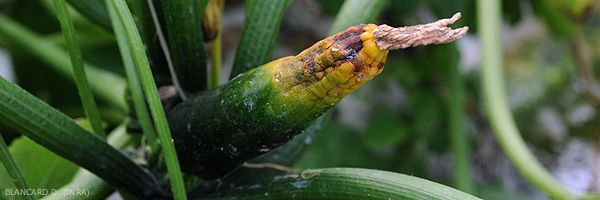
Apical necrosis
(blossom-end-rot)
This physiological disorder is reported almost everywhere in the world; it is quite common in the cultures of Cucurbitaceae, in particular on zucchini and squash.
It is initially manifested by the appearance of a watery zone, of limited size, at the apical or stylar end of the fruits. This gradually spreads, the affected tissues wilt as the fruit grows and take on a brown to black tint (Figure 1). The pulp decomposes more and more deeply and the fruits shrivel (figure 2).
Note that the symptoms of blossom end necrosis should not be confused with those of fruit sag, which are very comparable. Note that Pythium aphanidermatum and P. debaryanum have sometimes been associated with this symptom.
The expression of apical necrosis is influenced in particular by a lack of calcium associated with slow plant growth, a limited or damaged root system, root water stress, excess salts ...
To prevent this abiotic disease from manifesting, we advise you to practice the following measures:
- plant the crop in a plot with well-drained soil ;
- mulch the soil and optimize irrigation to maintain uniform soil moisture
- avoid damaging the root system during hoeing or weeding;
- control and maintain the pH soil at intermediate values making calcium available;
- beware of fertilizers and manures with a high content of fresh ammonia which can induce lush plant growth and bring other salts into the soil;
- bring calcium nitrate in soil or calcium chloride by foliar sprays to increase the amount of calcium available to the developing fruit.
It should be noted that a certain number of opportunistic fungi are capable of settling on the fruits and causing them to rot via the lesions caused by apical necrosis: Botrytis cinerea , Didymella bryoniae , Choanephora cucubitarum , Fusarium spp. .





